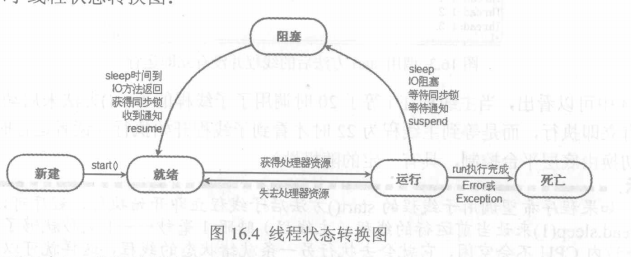一、線程的基本概念
JAVA Thread代碼中的狀態枚舉代碼爲:
public enum State {
//初始化Thread後但是未啓動
NEW,
//就緒狀態的線程,但是也有可能因爲來自操作系統的某些原因造成等待,隨時等待CUP進行調用。調用了start方法,也不一定馬上就能運行。
RUNNABLE,
//阻塞狀態,運行中的線程因爲原因造成了阻塞,直到進入就緒狀態,才能被CPU重新調用。
BLOCKED,
//等待狀態,包括三個方法:wait()、join()、LockSupport.park()方法。
//例如調用wait()方法後等待其他線程調用notify()與notifyAll()。
WAITING,
//該狀態爲一個具體時間限制的等待狀態。
//如以下方法:sleep(timeout)、wait(timeout)、join(timeout)、LockSupport.parkNanos、LockSupport.parkUntil
TIMED_WAITING,
//一個線程已經完成執行或者被打斷狀態
TERMINATED;
}線程生命週期示意圖:
二、java.lang.Thread
1. 構造函數:
public Thread() {
init(null, null, "Thread-" + nextThreadNum(), 0);
}
private void init(ThreadGroup g, Runnable target, String name,
long stackSize, AccessControlContext acc) {
//name必須不能爲空。
if (name == null) {
throw new NullPointerException("name cannot be null");
}
// private volatile char name[];爲name的聲明
this.name = name.toCharArray();
//父線程爲啓動線程
Thread parent = currentThread();
//打開java的安全管理器
SecurityManager security = System.getSecurityManager();
if (g == null) {
/* Determine if it's an applet or not */
/* If there is a security manager, ask the security manager
what to do. */
if (security != null) {
g = security.getThreadGroup();
}
/* If the security doesn't have a strong opinion of the matter
use the parent thread group. */
if (g == null) {
g = parent.getThreadGroup();
}
}
/* checkAccess regardless of whether or not threadgroup is
explicitly passed in. */
//判斷是否符合規則
g.checkAccess();
/*
* Do we have the required permissions?
*/
if (security != null) {
if (isCCLOverridden(getClass())) {
security.checkPermission(SUBCLASS_IMPLEMENTATION_PERMISSION);
}
}
g.addUnstarted();
this.group = g;
this.daemon = parent.isDaemon();
this.priority = parent.getPriority();
if (security == null || isCCLOverridden(parent.getClass()))
this.contextClassLoader = parent.getContextClassLoader();
else
this.contextClassLoader = parent.contextClassLoader;
this.inheritedAccessControlContext =
acc != null ? acc : AccessController.getContext();
this.target = target;
setPriority(priority);
if (parent.inheritableThreadLocals != null)
this.inheritableThreadLocals =
ThreadLocal.createInheritedMap(parent.inheritableThreadLocals);
/* Stash the specified stack size in case the VM cares */
this.stackSize = stackSize;
/* Set thread ID */
tid = nextThreadID();
}2. run和start
@Override
public void run() {
// private Runnable target;該target可以爲runnable的run。適用於實現runnable接口的初始化線程的方法。
if (target != null) {
target.run();
}
}
public synchronized void start() {
/**
* This method is not invoked for the main method thread or "system"
* group threads created/set up by the VM. Any new functionality added
* to this method in the future may have to also be added to the VM.
*
* A zero status value corresponds to state "NEW".
*/
if (threadStatus != 0)
throw new IllegalThreadStateException();
/* Notify the group that this thread is about to be started
* so that it can be added to the group's list of threads
* and the group's unstarted count can be decremented. */
group.add(this);
boolean started = false;
try {
start0();
started = true;
} finally {
try {
if (!started) {
group.threadStartFailed(this);
}
} catch (Throwable ignore) {
/* do nothing. If start0 threw a Throwable then
it will be passed up the call stack */
}
}
}
private native void start0();
3.join()主要是等待該線程死亡。主要作用是該線程執行完成後纔會運行join()後面的方法。
public final void join() throws InterruptedException {
join(0);
}
public final synchronized void join(long millis)
throws InterruptedException {
long base = System.currentTimeMillis();
long now = 0;
//如果時間小於0,則返回異常
if (millis < 0) {
throw new IllegalArgumentException("timeout value is negative");
}
if (millis == 0) {
//如果時間爲0,則一直等待直到當前線程死亡,即isAlive爲false;每次循環等待的時間爲0
while (isAlive()) {
wait(0);
}
} else {
//如果時間大於0,需要判斷當前時間與join方法調用時間之間的差距,如果時間差大於參數設置的時間,則不再等待循環結束直接跳出
while (isAlive()) {
long delay = millis - now;
if (delay <= 0) {
break;
}
wait(delay);
now = System.currentTimeMillis() - base;
}
}
}例子:1.不調用join的情況
public class TestThread {
public static void main(String[] args) throws InterruptedException {
MyThread thread = new MyThread();
MyThread1 thread1 = new MyThread1(thread);
thread1.start();
}
}
class MyThread1 extends Thread {
MyThread myThread;
public MyThread1(MyThread myThread) {
this.myThread = myThread;
}
public void run() {
myThread.start();
System.out.println("end");
}
}
class MyThread extends Thread {
public void run() {
int i = 0;
while (true) {
System.out.println(this.toString() + ":" + (i++));
if(i==5){
break;
}
try {
sleep(1000);
} catch (InterruptedException e) {
e.printStackTrace();
}
}
}
}輸出結果爲:
end Thread[Thread-0,5,main]:0 Thread[Thread-0,5,main]:1 Thread[Thread-0,5,main]:2 Thread[Thread-0,5,main]:3 Thread[Thread-0,5,main]:4
可以看到並沒有相應的順序和規律。
2.調用join()無參數的情況
修改MyThread1中的run()方法:
public void run() {
myThread.start();
try {
myThread.join();
} catch (InterruptedException e) {
// TODO Auto-generated catch block
e.printStackTrace();
}
System.out.println("end");
}輸出結果爲:
Thread[Thread-0,5,main]:0 Thread[Thread-0,5,main]:1 Thread[Thread-0,5,main]:2 Thread[Thread-0,5,main]:3 Thread[Thread-0,5,main]:4 end
可以看到一直運行MyThread這個線程,不會運行MyThread1線程join方法下面的代碼,這是由於會一直等待MyThread線程死亡,纔會運行主線程的代碼。
3.調用join()有參數的情況
修改MyThread1中的run()方法:
public void run() {
myThread.start();
try {
myThread.join(1000);
} catch (InterruptedException e) {
// TODO Auto-generated catch block
e.printStackTrace();
}
System.out.println("end");
}輸出結果爲:
Thread[Thread-0,5,main]:0 end Thread[Thread-0,5,main]:1 Thread[Thread-0,5,main]:2 Thread[Thread-0,5,main]:3 Thread[Thread-0,5,main]:4
可以看到在MyThread開始後,調用join(1000)後,會等待1000毫秒後,運行MyThread1的打印代碼。而不是無限等待MyThread的死亡。
該方法的主要內容可以保證主線程不會優先於子線程先死亡,即如果主線程啓動一個子線程,可以在子線程中調用主線程的join方法,這樣就可以保證子線程死亡後主線程纔會繼續往下運行。
三、java.lang.runnable
runnable爲接口,只有一個抽象方法run。必須實現該方法才能實現線程的調用。代碼如下:
public interface Runnable {
public abstract void run();
}四、java.util.concurrent.Callable與java.util.concurrent.FutureTask
1.該類爲第三種初始化線程的方法。即實現Callable中call方法,並用FutureTask包裝Callable類,通過Thread包裝FutureTask之後調用start方法開啓線程。call方法有返回值。調用方式如下:
public class TestCallable implements Callable<String> {
public static void main(String[] args) {
TestCallable testCallable=new TestCallable();
FutureTask futureTask=new FutureTask<String>(testCallable);
for(int i=0;i<100;i++){
System.out.println(Thread.currentThread().getName()+"循環變量i的值"+i);
if(i==70){
new Thread(futureTask,"有返回的線程").start();
}
if(i==80){
try {
System.out.println("子線程返回值"+futureTask.get());
} catch (InterruptedException e) {
// TODO Auto-generated catch block
e.printStackTrace();
} catch (ExecutionException e) {
// TODO Auto-generated catch block
e.printStackTrace();
}
}
}
}
@Override
public String call() throws Exception {
int i = 0;
for (; i < 100; i++) {
System.out.println(Thread.currentThread().getName() + ":" + i);
}
return String.valueOf(i);
}
}2.java.util.concurrent.Callable的代碼爲:可見邏輯主要是通過實現call的方法,並且有返回值
public interface Callable<V> {
V call() throws Exception;
}3.java.util.concurrent.FutureTask
構造函數主要是包裝Callable類。該類實現接口interface RunnableFuture<V> extends Runnable, Future<V>,因此可以使用Thread進行包裝並調用start啓動線程
public FutureTask(Callable<V> callable) {
if (callable == null)
throw new NullPointerException();
this.callable = callable;
this.state = NEW; // ensure visibility of callable
} 實現接口的run方法。
public void run() {
if (state != NEW ||
!UNSAFE.compareAndSwapObject(this, runnerOffset,
null, Thread.currentThread()))
return;
try {
Callable<V> c = callable;
if (c != null && state == NEW) {
//result爲callable的call()方法的返回值
V result;
boolean ran;
try {
//調用call並且將ran設置爲true
result = c.call();
ran = true;
} catch (Throwable ex) {
result = null;
ran = false;
setException(ex);
}
//將結果傳給futureTask的對象
if (ran)
set(result);
}
} finally {
// runner must be non-null until state is settled to
// prevent concurrent calls to run()
runner = null;
// state must be re-read after nulling runner to prevent
// leaked interrupts
int s = state;
if (s >= INTERRUPTING)
handlePossibleCancellationInterrupt(s);
}
}五、Thread、runnable與callable的區別。
1.runnable與callable初始化後必須作爲Thread的參數進行封裝,並調用Thread的start方法進行啓動線程。如下:
MyThread thread = new MyThread(); thread.start(); MyRunable runable=new MyRunable(); Thread runnableThread=new Thread(runable); runnableThread.start();
2.runnable與callable只有一個方法,如果需要調用sleep等方法,需要調用Thread中的方法。
3.建議使用runnable與callable實現線程的class,主要是因爲runnable爲接口,java中不支持多繼承,但支持多接口,如果繼承Thread來實現線程,那麼就無法再繼承別的父類了。
4.runnable實現run方法;callable實現call方法,有返回值,有異常返回。

